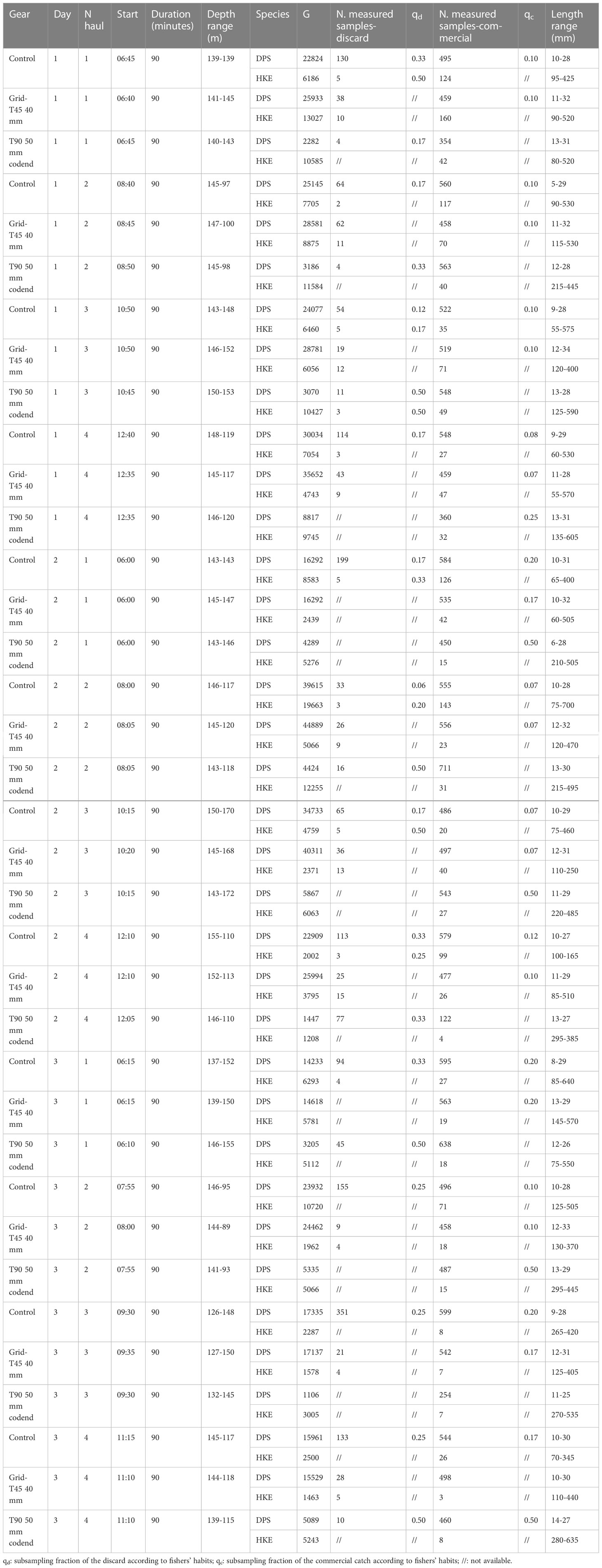- 1Department of Biological, Geological and Environmental Sciences (BiGeA) – Marine Biology and Fisheries Laboratory of Fano (PU), University of Bologna, Bologna, BO, Italy
- 2Institute for Marine Biological Resources and Biotechnology (IRBIM), National Research Council – CNR, Mazara del Vallo, TP, Italy
- 3Department of Integrative Marine Ecology, Stazione Zoologica Anton Dohrn (SZN), Palermo, Italy
- 4National Biodiversity Future Center (NBFC), Palermo, Italy
Introduction: Most Mediterranean fish stocks are overexploited owing to high fishing efforts and poor exploitation patterns. Demersal trawl fisheries are considered the most impactful fishery type because of the high quantities of unwanted catch that is then routinely discarded at sea.
Methods: In the present study, two types of by-catch reduction devices (BRDs), that is a sorting grid (Grid-T45 40 mm) and a T90 50 mm codend, were compared to a typical commercial bottom trawl net (control) in terms of size structures and catch per unit effort to assess the effect of gear modification on the selectivity of crustacean fisheries in the central Mediterranean Sea. In particular, three randomly selected trawlers were involved in a paired hauls experiment fishing at the same time in the same fishing ground. Each trawler carried out four hauls per day during a 3-day campaign for a total of 36 hauls. The target species of the fishery is Parapenaeus longirostris (herein DPS), and the main commercial by-catch is Merluccius merluccius (herein HKE).
Results: The results showed that the landing per unit effort (LPUE) of DPS was higher for Grid-T45 40 mm net, although it did not differ significantly from that of the control net. Conversely, the discard per unit effort (DPUE) of the control net was significantly higher than of both BRD configurations. For HKE, a slightly higher LPUE was recorded using the T90 50 mm codend compared to that of the control, but this result was not statistically significant. The lowest DPUE was found for the T90 50 mm codend, with significant differences compared to that of the control and Grid-T45 40 mm net. The catch comparison of the size structures analysed through generalised linear mixed models highlighted that the Grid-T45 40 mm net was more effective in catching adult DPS, whereas the T90 50 mm codend was more selective for adult HKE.
Discussion: In conclusion, although further studies should be carried out in future to test the performance of the BRDs in different areas and seasons, the investigated gear seems to be promising for reducing the catch of undersized individuals and contributing to mitigating the current overfishing of DPS and HKE.
1 Introduction
The Mediterranean Basin is affected by a very high level of human pressure (Micheli et al., 2013). Among these pressures, fisheries are considered one of the main sources of impact on marine ecosystems, with most of the exploited stocks being overfished (Colloca et al., 2013; Vasilakopoulos et al., 2014; Colloca et al., 2017). Despite efforts to establish an effective legal framework and ensure the implementation and compliance of the fishery sector, 75% of the assessed stocks in the Mediterranean are still considered to be threatened by overfishing (Food and Agriculture Organization (FAO), 2020). Furthermore, the increasing level of fishing effort applied in the last three decades has led to profound modification of the marine ecosystem in terms of loss of biodiversity (Coll and Libralato, 2012; Piroddi et al., 2017).
Among the different fisheries, bottom trawling is considered one of the most impactful techniques in the Mediterranean, due to high quantities of unwanted catch, including the incidental catch of non-target species and juveniles of both target and non-target species, which are either discarded because of their low economic value or because of legal restrictions (Pravin et al., 2011; Gorelli et al., 2016; Tsagarakis et al., 2017; GFCM, 2018; Sardo et al., 2020a).
In the Strait of Sicily, one of the most productive areas for demersal resources in the Mediterranean Sea, a large trawler fleet is present, where 785 trawlers from Italy, Malta, and Tunisia exploit shared resources in international waters (Colloca et al., 2017). Among the different species targeted by bottom trawling, the deep-water rose shrimp Parapenaeus longirostris Lucas, 1846 (herein DPS) is one of the most important in terms of landings and revenue (Di Maio et al., 2022). However, in the DPS trawl fisheries of the Strait of Sicily, a discarded fraction of 25-40% of the total catch has been reported (Milisenda et al., 2017). Therefore, the General Fisheries Commission for the Mediterranean (GFCM) adopted the Recommendation GFCM/44/2021/12 on a multiannual management plan for bottom trawl fisheries exploiting demersal stocks in the Strait of Sicily, which aims to ensure the sustainable use of marine living resources through measures to prevent overfishing, including selectivity to minimise discard. In addition, according to Reg. UE 1241/2019, fishermen must use square mesh codends (terminal end of the net) with a minimum mesh size of 40 mm or, only upon approval of a request, a 50 mm diamond mesh. These legal codend mesh sizes allow the catching adults of small to medium sized species, such as shrimps, red mullet, and cephalopods, but do not prevent the catching of undersized specimens of medium to large sized species, such as European hake (Merluccius merluccius, herein HKE), monkfish, and horse mackerel (Vitale et al., 2018a; Vitale et al., 2018b; Lucchetti et al., 2021). Because adopting a larger mesh size in the codend implies a strong reduction in the valuable fraction of catch, different technical solutions are being tested to modify the mesh shape to reduce the unwanted by-catch from trawling in the Mediterranean Sea. Considering the selectivity of the T90 (i.e., a diamond mesh turned 90°) codend, this solution was tested in the Adriatic Sea (Petetta et al., 2020) and the Aegean Sea (Dereli and Aydin, 2016; Deval et al., 2016; Genç et al., 2018), but not in the Strait of Sicily. The T90 codend, compared to other meshes currently used by trawlers, should remain more open during fishing operations, allowing undersized fishes and shrimps to escape. Given that the T90 codend is a very simple modification that does not involve any technical handling problems or any safety risk, it could be more easily accepted by fishing communities of the Strait of Sicily. Other promising by-catch reduction devices (BRDs) are the sorting grids, which are placed in the extension section of the trawl net. In the Mediterranean, the adoption of sorting grids in bottom trawling fisheries was tested to avoid catching undersized specimens of the target species, such as DPS and HKE (e.g., Sardà et al., 2004; Sardà et al., 2005; Bahamon et al., 2007; Aydın and Tosunoğlu, 2012; Vitale et al., 2018a; Vitale et al., 2018b), as well as to reduce the unwanted by-catch of sharks (Brčić et al., 2015) and sea turtles (Lucchetti et al., 2016; Lucchetti et al., 2019). The grid tested in the present study was similar to that tested by Vitale et al. (2018a); Vitale et al. (2018a), but the novelty was that, for the first time, to our knowledge, it was installed in a commercial, rather than an experimental, trawl net. In particular, it was constructed with a steel frame and a stretched 40 mm square mesh in the selective area. The fishes and shrimps were conveyed toward the selective area of the grid through a funnel, allowing them to pass through this area, thus by-catch could be released, while the individuals that did not pass through the grid meshes were pushed down and retained by the codend mesh. Although the previous finding of all relevant studies point to a generally positive impact of sorting grids on the size at capture of commercial species as well as reducing the amount of unwanted by-catch, their adoption in Mediterranean trawl fisheries remains very low. The lack of sorting grid implementation could be linked to several causes, including fishers’ resistance to changing their behaviour and, consequently, their unwillingness to modify their fishing gear (Vitale et al., 2018a). Other possible causes are linked to the lack of efficient technology transfer from researchers to fishers (e.g., Morrissey and Almonacid, 2005) as well as the overall weakness of fishing management in the Mediterranean region (Colloca et al., 2017).
To reduce the catch of undersized DPS and of HKE (unwanted by-catch according to the definition provided by ICES, 2020), the present study explored options to facilitate the transfer of BRDs to DPS trawl fisheries, showing important implications for their long-term sustainability, in- line with the management goals of the EU Common Fisheries Policy, CFP (reg. EC 1380/2013).
2 Material and methods
2.1 Study area
The study area, located in the northern part of the Strait of Sicily, belongs to Geographical Sub-Area 16 (GSA16 - South of Sicily), according to the GFCM classification (GFCM, 2007; Figure 1). GSA16 is characterised by a wide continental shelf with an intense hydrographic circulation pattern, a stable upwelling system, and high biodiversity (Di Lorenzo et al., 2018). These abiotic and biotic features lead to high productivity of fish resources, which are exploited by a multinational fleet in national and international waters (Di Maio et al., 2022; Falsone et al., 2022; Jarboui et al., 2022).

Figure 1 Maps of the hauls carried out with the control (blue line), T90 50 mm codend (green line), and Grid-T45 40 mm (red line) nets over 3 days of the survey. The study area is highlighted with a red square box.
2.2 Sampling design
In December 2020, a 3-day selectivity campaign was conducted with three trawlers based at the Mazara del Vallo harbour. The fishing vessels operated simultaneously and in parallel according to a paired hauls design (Wileman et al., 1996) in a DPS fishing ground where the main commercial by-catch, according to the definition of ICES (2020), is HKE (Figure 1).
Given that the involved trawlers were not exactly the same in terms of overall length, to assess the potential variability among them, the swept area (A) of each haul to which the catch was estimated according to the formula proposed by Sparre and Venema (1998):
where D is the distance covered during the haul, Hr is the length of the head-rope, and X is a fraction of Hr. Multiplying X * Hr gives the width of the path swept by the trawl, the so-called wing ‘spread’. According to Pauly (1980), a value of X of 0.5 is the best compromise for a demersal otter trawl. Finally, for each haul, the higher swept area recorded by a vessel was compared to the other areas as a percentage difference (Δ%) (Table S1).
On a daily basis, each vessel carried out four hauls of 90 min (usually in the commercial fishery, the haul duration ranged between 120 and 150 min) for a total of 12 hauls per day per vessel and 36 hauls over the campaign. In particular, one vessel used a control net; namely, a typical trawl net used by the Italian fleet in the Strait of Sicily with a 40 mm square mesh codend, whereas the other two vessels rigged the nets (test) with a sorting grid (i.e., Grid-T45 40 mm; see section 2.3 and Vitale et al., 2018a, for details) in the extension section (just in front of the codend) and a T90 50 mm codend, respectively. Due to the SARS-CoV-2 pandemic, scientific observers were unable to follow fishing operations on board. To overcome this problem, a video camera was installed on the stern of each vessel to register all fishing operations. The fishers were trained on the aims of the project and the sampling procedures of the commercial and discarded fractions of DPS and HKE. In particular, for the purpose of the study, for each haul the on-board activity included: i) recording of the geographical coordinates, depth, and fishing time (start and end); ii) sorting the catch and sampling the commercial fraction of DPS and HKE selected according to the fishers’ habits; iii) recording the weight (in kg) of the commercial catch of DPS and HKE by counting the box number (a box of DPS corresponded to 2 kg, while a box of HKE corresponded to 6 kg), iv) sampling the discarded marine organism fraction (including undersized specimens of DPS and HKE); and v) recording the total amount of marine organisms rejected and returned to the sea, the so-called discard. Each fishing trip was monitored remotely using an AIS tracking system. The sorting of the catch on-board and how fishers sub-sampled discard were assessed through visual inspection of the frame recorded by the video camera. The recordings of discard sampling were compared to the fishers’ self-reported data. In addition, given that the number of hauls carried out on each fishing day was known (i.e., four), the number of boxes of both species was counted at the landing port, which was compared with the fishers’ self-reported data by summing the number of boxes reported in each haul. Representative samples of DPS and HKE commercial (one box per category) and discarded (5–10 kg, min–max, of discard) fractions by haul were brought to the National Research Council (CNR) laboratory, weighed (0.1-gram accuracy), and measured (to the nearest 5 mm total length [TL] for HKE and to the nearest 1 mm for carapace length [CL] of DPS) individually.
2.3 Gear description
During the campaign, the vessels used very similar trawl nets, except for the BRDs (Supplementary Figures 1–3).
2.3.1 Control trawl with a T45 40 mm codend
The control trawl was built with a nominal 50 mm diamond mesh and polyamide nylon netting in the main body and extension sections of the net whereas the codend had a 40 mm square mesh. The control trawl had an overall length of 54.75 m, a 57 m-long headrope (diameter, hereinafter Ø, 24 mm, polyamide–stainless-steel combined material), a 64.90 m-long footrope (Ø 36 mm, polyamide–stainless-steel combined material) with steel chain, and 800 and 900 meshes of circumference in the upper and lower part of the net, respectively (Supplementary Figure 1). It was rigged with two bottom trawl doors high yield type (150×95 cm, 200 kg each).
2.3.2 Test trawl mounting Grid-T45 40 mm
The design of the test trawl, which mounted the grid system in the extension section, was equivalent to that of the control trawl. Therefore, the only major difference between the two trawls was the presence of the grid in the test one. The sorting grid was similar to that tested by Vitale et al. (2018a), including a funnel panel (opening 20 mm, square mesh) of approximately 3 m, adapting its size to the local trawl nets (Figure 2). Specifically, the grid was built with a stretched net of 40 mm square mesh (selective area of the grid) directly sewn to a steel frame (150 × 110 cm) and placed in the extension part of the trawl net. Other slight differences to the control trawl were their overall length (54.75 m control vs 56 m Grid-T45 40 mm), the headrope length (57 m control vs 60 m Grid-T45 40 mm), and the footrope length (64.90 m control vs 68 m Grid-T45 40 mm) (Supplementary Figure 2). It was rigged with two bottom trawl doors high yield type (158 × 97 cm, 230 kg each).
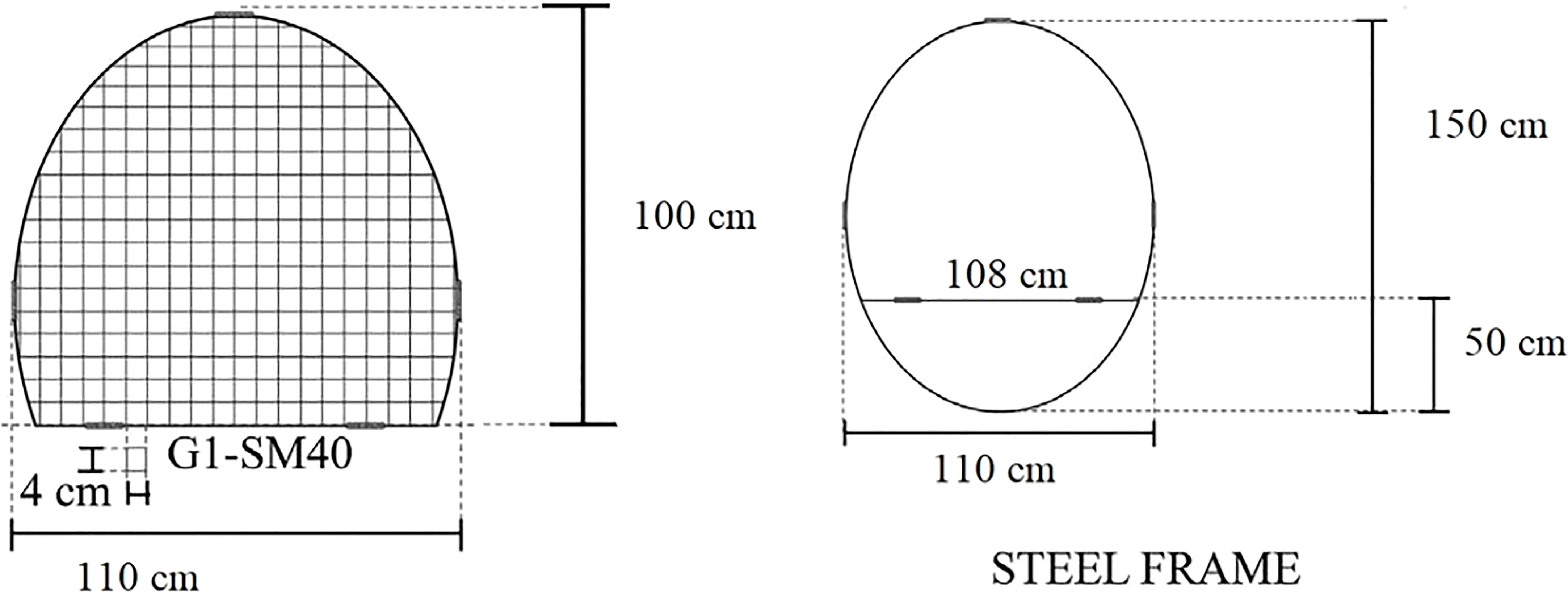
Figure 2 The sorting grid used during the bottom trawl campaign and its size features (modified from Vitale et al., 2018a).
2.3.3 Test trawl mounting T90 50 mm codend
The design and dimensions of this test gear were similar to those used in the DPS fishery, except for the T90 50 mm codend. The trawl slightly differed from the control one for the overall length (54.75 m control vs 55.15 m T90 50 mm codend), the headrope length (57 m control vs 58 m T90 50 mm codend), and the footrope length (64.90 m control vs 66 m T90 50 mm codend) (Supplementary Figure 3). The trawl was spread using the same trawl doors as the Grid-T45 40 mm.
Notably, the extension pieces of the three trawl nets were cylindrical, with a total length of 10 m and 500 meshes in circumference, whereas the codend was 6 m long, with a twine Ø of 3 mm and 350 meshes in circumference. The sweeps of the three trawls were approximately 652 m long (slightly changing according to the depth of the fishing ground) and had a Ø of 14 mm, while warps were approximately 250 m long and had a Ø of 30 mm.
The mesh openings of the extension pieces and the codends of the three types of gears were measured 30 times each in wet conditions with a digital Vernier calliper, with a 4 kg weight tied vertically to the stationary jaw (Cárdenas et al., 1997; Aydın and Tosunoğlu, 2012). The meshes in the extension section of the three nets were equal to 48.95 ± 2.10 mm (control; mean ± standard error), 49.10 ± 1.56 mm (Grid-T45 40 mm), and 50.21 ± 1.34 mm (T90 50 mm codend). The meshes in the codends were 39.45 ± 1.13 mm (control), 38.95 ± 1.56 mm (Grid-T45 40 mm), and 49.65 ± 1.45 mm (T90 50 mm codend).
2.4 Catch comparison analysis
2.4.1 Landing per unit effort and discard per unit effort
The commercial and discarded DPS and HKE fractions classified according to the fishers’ habits had two different subsampling ratios (where the subsampling ratio was calculated as sample in kg/total catch in kg). To ensure that the global subsampling was correctly calculated, the methodology proposed by Cosgrove et al. (2019) was applied. The required sub-sampling ratio for the combined discarded (qd) and commercial (qc) fractions solves the following equation:
where is the raised count of the discard and is the raised count of the commercial fraction. Re-arranging (2) gives the following equation:
This demonstrates that the combined sub-sampling ratio of the combined fractions was length-dependent. This ensures that the raised counts for the total (right-hand side of Equation 2) were equal to the sum of the separately raised counts (left-hand side of Equation 2). After being raised, the DPS and HKE individuals were re-classified into commercial and discarded fractions according to the minimum conservation reference size (MCRS) defined by Reg. EU 1241/2019, that is, above (commercial) and below (discarded) 20 mm CL and 200 mm TL, respectively. Then, their total weight in kg was standardized to 1 h to obtain the catch per unit effort (CPUE) expressed as kg/h by species. In particular, the catch rates of the commercial fraction were herein named landing per unit effort (LPUE) while the catch rates of the discard fraction were herein named discard per unit effort (DPUE). Linear mixed models (LMMs) were applied by species to evaluate whether the control and test nets differed significantly, without any assumption regarding the direction (i.e., two-tailed). The catch rates were contrasted against gear on a logarithmic scale, including the hauls as a random intercept, i.e., assuming that an intercept was different for each level of the variable ‘gear’. To check the significance of the variable ‘gear’ in the model, a likelihood ratio test was applied. In the case of significant differences, post-hoc Tukey HSD tests were performed to compare the gear to one another. To directly interpret the coefficient estimates of the LMMs and Tukey HSD tests, they were transformed as antilogs. The LMMs were run through the ‘lme4’ package (Bates et al., 2015) whereas the Tukey HSD test used the ‘multicomp’ package (Hothorn et al., 2008). All analyses were carried out in R Studio version 3.6.3 (R Core Team, 2020).
2.4.2 Size structures
The probability of retaining a fish of a given length in the test net in relation to the total catch was assessed according to the method proposed by Fryer et al. (2003) and Holst and Revill (2009). A comparison was made between 12 hauls (i.e., 12 in the test and 12 in the control nets), and the length classes were set at 2 mm CL and 20 mm TL for DPS and HKE, respectively. The undersized specimens were identified as fish with lengths below the MCRS.
The observed average catch comparison for each length class (CCl) was expressed as follows:
where nc and nt are the number of fish caught in each length class l in the control and test nets, respectively (e.g., Vitale et al., 2018a; Geraci et al., 2021a). The observed proportion of catch caught in the test gear of each selected species was modelled to obtain a catch comparison curve using generalised linear mixed models (GLMMs) with a binomial distribution, where hauls were included as random intercept, using the Laplace approximation, to remove the variance linked to the expected change in abundance/catchability of the investigated species during the days and timeframes (Holst and Revill, 2009). A value of 0.5 for the catch comparison curves, CC(l), indicates that there is the same probability of capturing a fish of length l in the test and control. A value above 0.5 indicates a higher probability of catching a fish of length l in the test compared to the control, and vice versa for a value below 0.5. The global sub-sampling ratio (ql, see Section 2.4.1) in the test and control nets was also included as an offset in the model (Fryer et al., 2003; Holst and Revill, 2009). In addition, the models were fitted using splines with different degrees of freedom (df). The df in the model were assigned based on the fitting of predictions and observations. Subsequently, the model fit was checked by assessing the residuals.
To directly quantify the relative length-dependent gear catch efficiency of the test versus control net, the so-called ‘catch ratio’ (CR), that is, the ratio between the catch of the control and test trawl nets of a given length, l, was estimated (e.g., Melli et al., 2020; Lomeli et al., 2021; Geraci et al., 2021a). In particular, CR(l) was computed as:
being CC(l) the predicted values of the catch comparison model (based on Equation 4). A value of 1.0 for CR(l) indicates no difference in catch efficiency between the test and the control. On the other hand, a value of 0.60 or 1.45 indicates that the probability of fish being caught for a given length with the test net is 40% less or 45% more, respectively, than that sampled with a control net. To provide a global idea of the effect of the tested BRDs, the CR(l) has been shown as the overall mean. The 95% confidence intervals of CC(l) and mean CR(l) were estimated from the model predictions and using the qt() function in R language to return the inverse probability cumulative density of the Student t-distribution. All size structure analyses were carried out with R version 3.6.3 using the package ‘glmmTMB’ (Brooks et al., 2017).
3 Results
3.1 Operational information and catches
The depth of the surveyed fishing grounds ranged between 89 and 170 m (i.e., the continental shelf). The commercial sub-sampled fraction for DPS ranged between 2 and 15 whereas no subsampling was required for the commercial fraction of HKE. The sub-sampling fraction of the discard for DPS ranged between 2 and 16, whereas that for HKE ranged between 2 and 6. The size ranges of the DPS specimens caught by the control and T90 50 mm codend (5/6–31 mm CL) were very similar, while specimens retained by the Grid-T45 40 mm net were slightly bigger (10–34 mm CL). The size ranges of HKE specimens were 55–700 mm TL for the control, 55–570 mm TL for Grid-T45 40 mm, and 75–635 mm TL for the T90 50 mm codend (Table 1).
3.2 LPUE and DPUE
The LPUEs of the DPS, were higher for the Grid-T45 40 mm configuration than for either the control or T90 50 mm codend, whereas the DPUEs were highest for the control gear. Conversely, the lowest catch rates were recorded for the T90 50 mm codend, for both LPUE and DPUE (Figure 3; Table 2). The LMMs considering LPUEs and DPUEs of DPS showed significant differences between the gear (LPUE, p< 4.045-13; DPUE, p< 2.2-16). In particular, for LPUEs the HSD Tukey post-hoc test revealed significant differences between the T90 50 mm codend and control net and between the two BRDs, whereas no significant difference between the Grid-T45 40 mm and control net was recognized. The DPUEs differed significantly for all gear (Table 3).
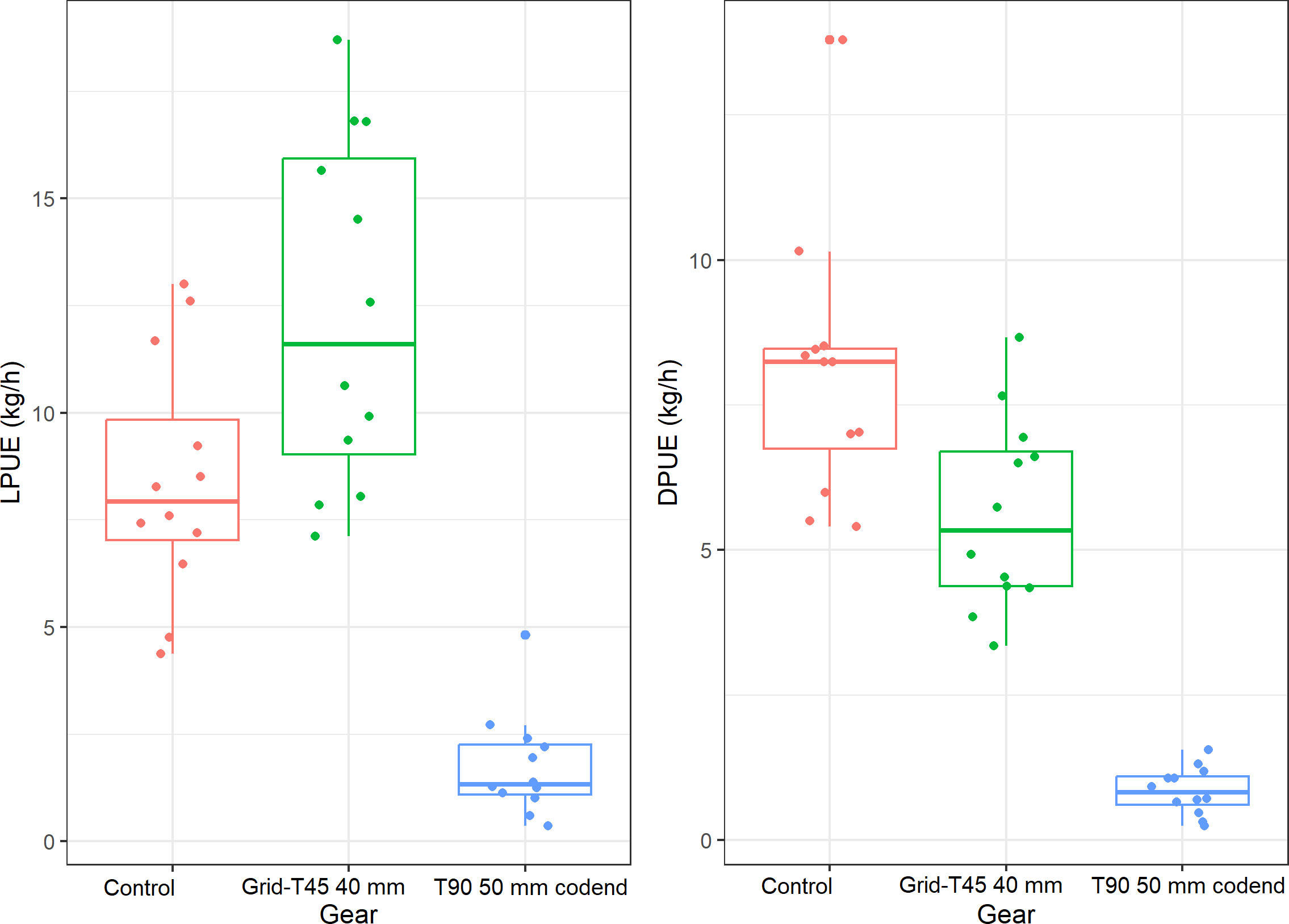
Figure 3 Boxplots of Parapenaeus longirostris (herein DPS) catch rates (kg/h) per gear caught during the campaign classified in landing per unit effort (LPUE; commercial) – left – and discard per unit effort (DPUE; discard) – right – according to the minimum conservation reference size (MCRS) established by the Reg. EU 1241/2019.
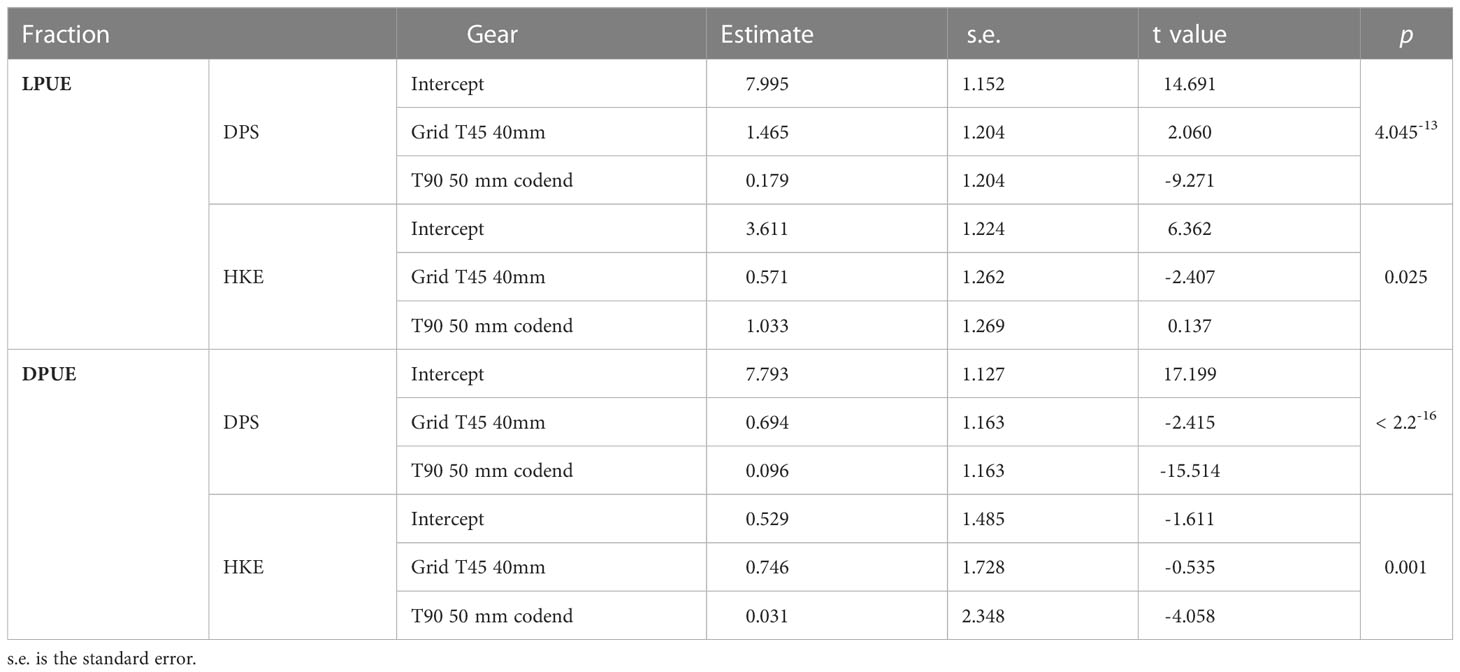
Table 2 Coefficient estimates for the catch rates of DPS and HKE modelled through linear mixed models in the catch fraction (commercial, LPUE and discard, DPUE).
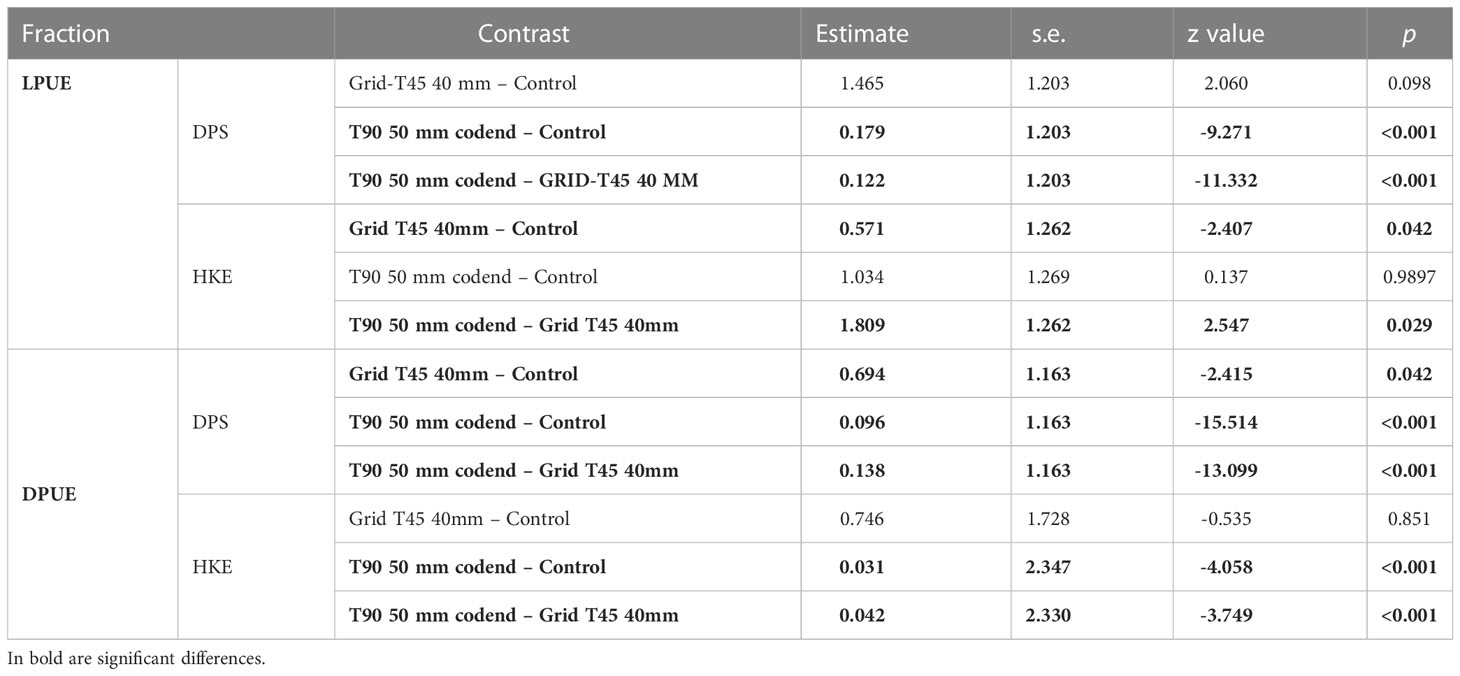
Table 3 Outcomes of the Tukey HSD post-hoc test of the catch rates of DPS and HKE, classified in catch fraction (commercial, LPUE and discard, LPUE), among different gear.
For HKE, slightly higher median LPUEs were recorded using the T90 50 mm codend, followed by the control net, whereas the DPUEs were higher for the control gear and negligible for the T90 50 mm codend (Figure 4). The LMMs for LPUEs and DPUEs of HKE showed significant differences among the gear (LPUE, p = 0.025; DPUE, p = 0.001). Specifically, for LPUEs, the Tukey HSD post-hoc test revealed significant differences between Grid-T45 40 mm and control net and between the two BRDs, whereas no significant difference between the T90 50 mm codend and control net was recognised. For DPUEs, significant differences between the pairwise comparison of Grid-T45 40 mm–T90 50 mm codend and T90 50 mm codend–control were detected (Table 3).
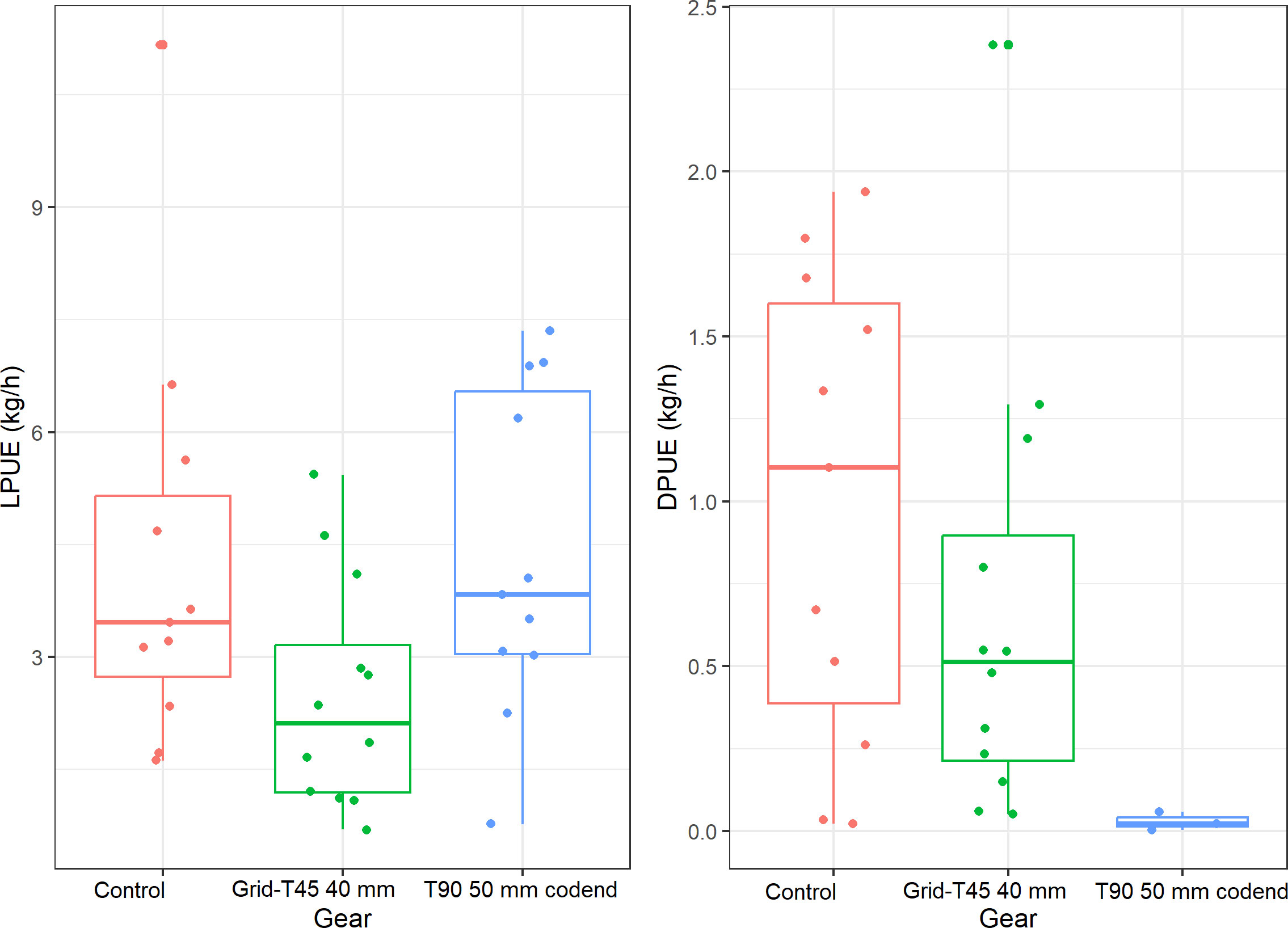
Figure 4 Boxplots of Merluccius merluccius (herein HKE) catch rates (kg/h) per gear caught during the campaign classified in landing per unit effort (LPUE; commercial) – left – and discard per unit effort (DPUE; discard) – right – according to the minimum conservation reference size (MCRS) established by the Reg. EU 1241/2019.
3.3 Size structures analyses
The length-frequency distributions of DPS and HKE showed that the bulk of the catch of the control was mainly composed of undersized specimens, indicating a potentially poor selectivity of the gear with legal mesh size in the codend. As for the BRDs, the Grid-T45 40 mm caught more commercial DPS whereas the T90 50 mm codend was more effective in catching adult HKE (Figures 5C, 6C).
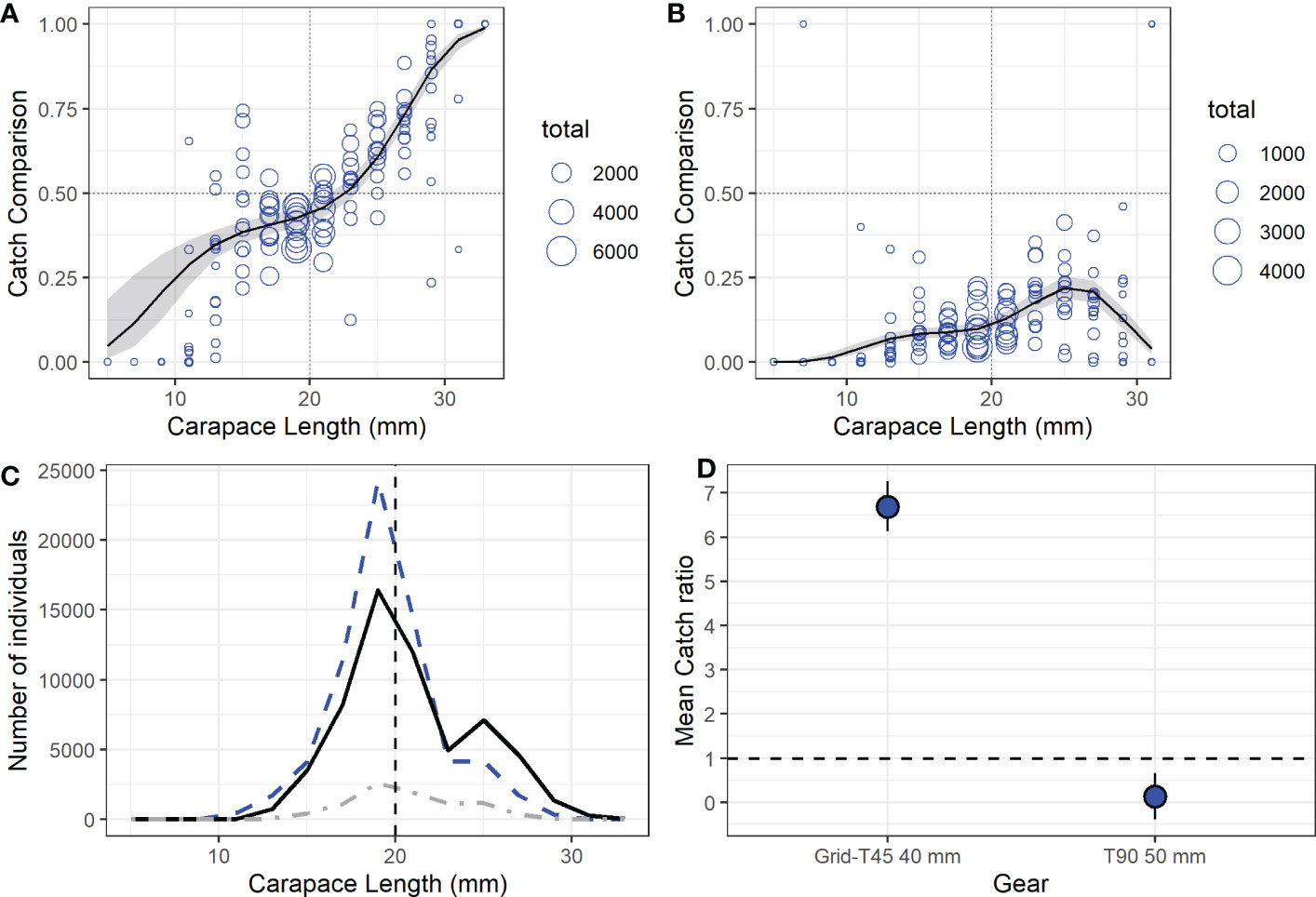
Figure 5 (A) Catch comparison curves for DPS caught with the Grid-T45 40 mm, and (B) with the T90 50 mm codend. Blue circles show observed proportions by haul, black dashed lines represent the model prediction, and the grey band indicates the 95% confidence limit. The level of no effect (CC(l) = 0.5) is shown by horizontal black dashed lines while the MCRS is shown by the black vertical dashed lines. (C) Length frequency distributions of DPS caught during the campaign. The blue dashed line represents the control, the continuous black line represents the Grid-T45 40 mm, and the dark grey line represents the T90 50 mm codend. Black vertical dashed lines depict the MCRS according to the Reg. EU 1241/2019. (D) The blue dots indicate the mean catch ratio (CR(l)), and horizontal bars indicate the 95% confidence limit. The level of no effect (CR(l) = 1.0) is depicted by horizontal black dashed lines.
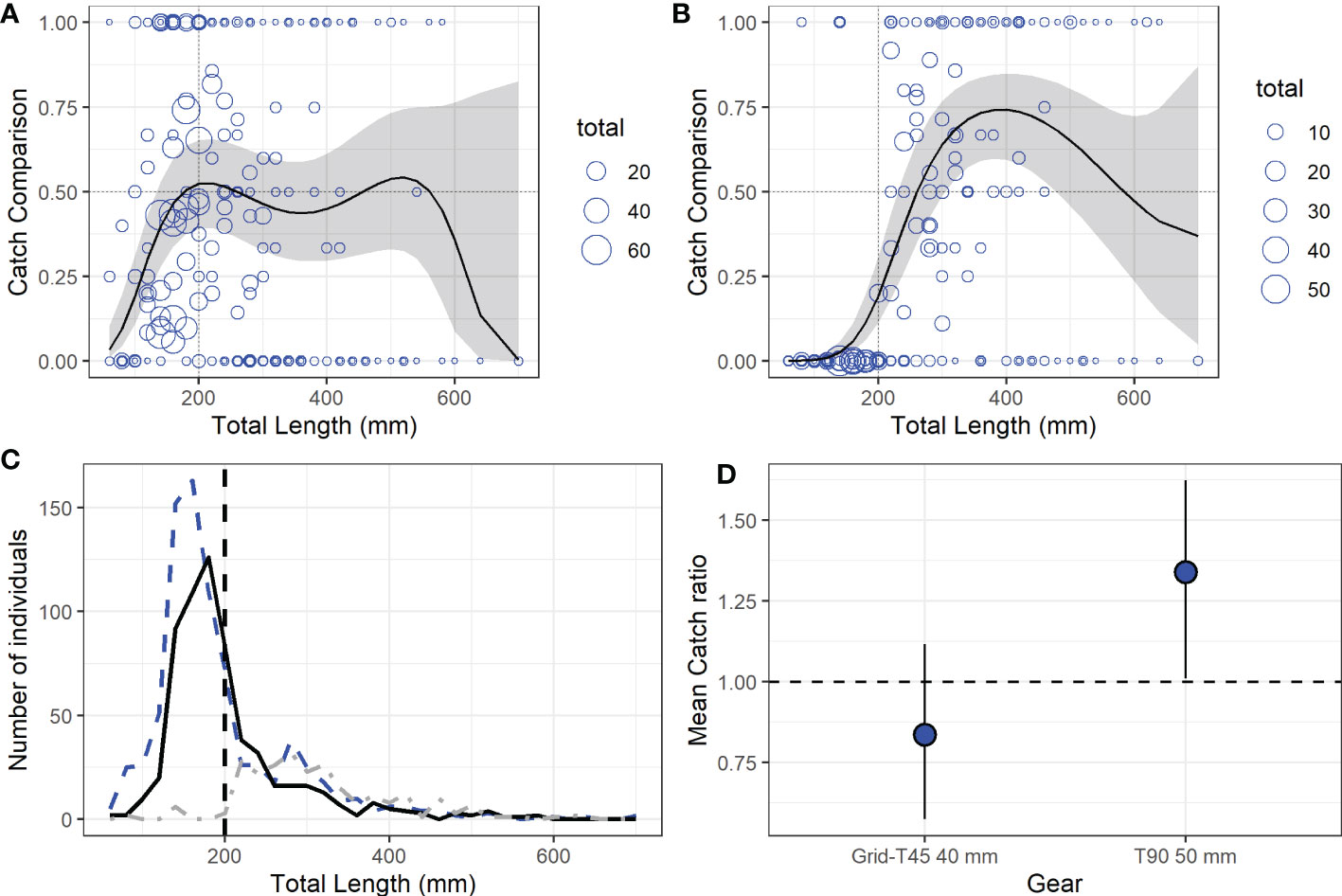
Figure 6 (A) Catch comparison curves for HKE caught with the Grid-T45 40 mm, and (B) with the T90 50 mm codend. Blue circles show observed proportions by haul, black dashed lines represent the model prediction, and the grey band indicates the 95% confidence limit. The level of no effect (CC(l) = 0.5) is shown by horizontal black dashed lines while the MCRS is shown by the black vertical dashed lines. (C) Length frequency distributions of DPS caught during the campaign. The blue dashed line represents the control, the continuous black line represents the Grid-T45 40 mm, and the dark grey line represents the T90 50 mm codend. Black vertical dashed lines depict the MCRS according to the Reg. EU 1241/2019. (D) The blue dots indicate the mean catch ratio (CR(l)), and horizontal bars indicate the 95% confidence limit. The level of no effect (CR(l) = 1.0) is depicted by horizontal black dashed lines.
The catch comparison, modelled through GLMMs for DPS, was run with 3 df when considering the Grid-T45 40 mm and control, whereas 4 df were set for the T90 50 mm codend vs. control. As for HKE concerns, 4 df (Grid-T45 40 mm vs Control) or 3 df (T90 50 mm codend vs Control) were used.
The final GLMMs by species, including their R codes, are presented in Table 4.
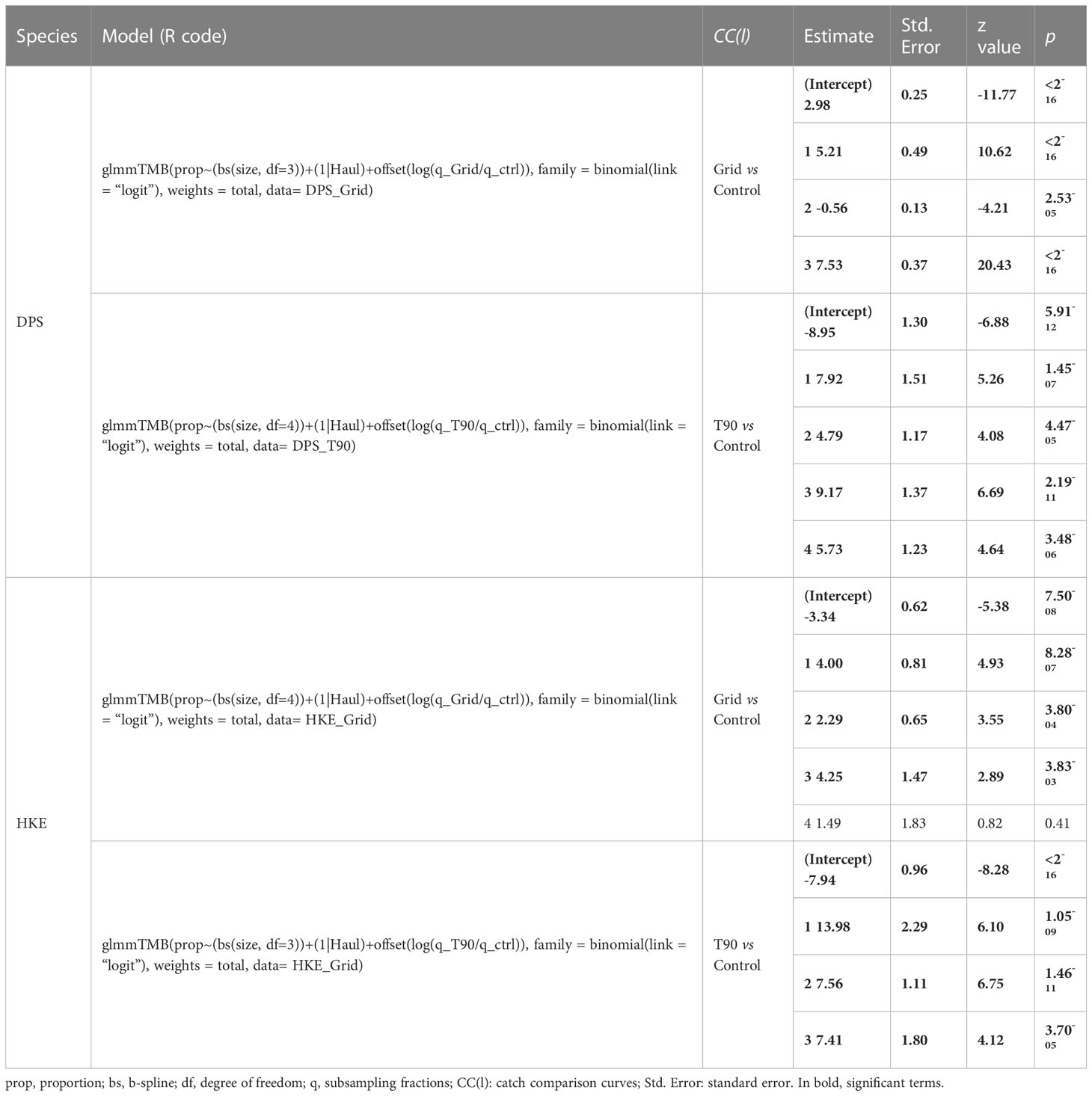
Table 4 Selected GLMM models with coefficients estimates for the catch comparison curves (test vs control net) of DPS (Parapenaeus longirostris), and HKE (Merluccius merluccius) and the used R code to run them.
In particular, for DPS the Grid-T45 40 mm had a lower probability of catching undersized specimens compared to the control as the CC(l) values were always lower than the level of no effect, that is, the same probability of catching an individual at a given length for both types of gear, or numerically CC(l) = 0.5. In contrast, there was an increase in the CC(l) recorded for adults, showing that the Grid-T45 40 mm had a higher catch probability than the control, particularly for legal-sized specimens. An important increase in catch above the level of no effect was detected for individuals from 25 mm CL onward (Figure 5A). This trend is reflected in the mean CR(l), which is very high (6.68, confidence interval: 6.63–6.77) (Figure 5D). However, the probability of catching DPS was always lower for the T90 50 mm codend configuration than for the control net (Figures 5B, D).
For HKE, the Grid-T45 40 mm showed lower efficiency than the control in capturing undersized fish. Conversely, the probability of catching adults was equal to that of the control (Figure 6A). Importantly, the T90 50 mm codend showed a lower probability of catching undersized HKE specimens, whereas the CC(l) values generally exceeded the level of no effect for commercial-sized specimens, except for a few individuals caught in the latest size classes (Figure 6B). The mean CR(l) was below and above the level of no effect (CR(l) = 1.00) for Grid-T45 40 mm and T90 50 mm codend, respectively (Figure 6D).
4 Discussion
The adoption of both BRDs in DPS fisheries resulted in a reduction in the number of undersized DPS and HKE specimens in the catches, suggesting a potential overall enhancement in the exploitation pattern. In particular, the Grid-T45 40 mm seems to be a technological solution that could be capitalised on by commercial trawlers targeting DPS. In fact, the Grid-T45 40 mm provided a higher LPUE and a significant reduction in undersized DPS when compared to the other trawl net configurations. However, the T90 50 mm codend, tested in the Strait of Sicily for the first time, strongly reduced the catch of both legal and undersized DPS, thus, would not ensure the economic sustainability of the DPS fisheries. Regarding HKE, the most efficient gear was the T90 50 mm codend. It is worth noting that, although this device excluded almost all of the undersized HKE, higher catch rates were recorded for HKE due to an elevated number of legal-sized specimens. Given that the Tukey test did not detect significant differences between the LPUE of the T90 50 mm codend and the control, while overall the CC(l) highlighted a higher efficiency for the T90 50 mm codend in catching larger-sized HKE, an apparent inconsistency appeared. These differences were due to the different analyses applied; in particular, Tukey’s test compared the mean value of catch regardless the size structure while CC(l) described the variation of proportions in the catch of individuals by size, making it more informative in terms of selectivity aspects.
Considering the intrinsic relationship between the ecological purpose of the MCRS and mesh size, it seems clear that the common goal is to avoid catching juveniles until they are large enough to spawn (Beverton and Holt, 1957). From an economic standpoint, this means that juveniles are given time to grow to an economically valuable size before harvest. Indeed, according to Vasilakopoulos et al. (2014), overexploitation of HKE juveniles was particularly severe as they were being harvested during the first and second years of life before reaching sexual maturity. Despite the basic nature of this notion, the identification of an adequate legal mesh size could involve practical difficulties and management problems, mainly in fisheries where small-sized species, such as DPS, are caught together with fish that can reach a large size, such as HKE (Caddy, 1990; Fiorentino and Vitale, 2021). In other words, the adoption of a more selective mesh size for HKE would imply the loss of a large number of shrimp and other small-sized species, significantly reducing fishery profitability (Lucchetti et al., 2021).
For sorting grids, Vitale et al. (2018a) used an experimental trawl net with Grid-T45 40 mm in the same area and found a high sorting capability for DPS and HKE in the reduction of undersized specimens with a minor loss of the marketable fraction for DPS; however, similar to the present study, a low amount of legal-sized HKE was retained by the Grid-T45 40 mm (Table 5; Vitale et al., 2018a). Similarly, Vitale et al. (2018a) further reported a higher number of larger-sized DPS individuals caught with the Grid-T45 40 mm compared to the control. These confirmed results could be due to the slightly higher vertical aperture of the trawl equipped with the Grid-T45 40 mm allowing the catching of larger DPS individuals while remaining at a greater height from the bottom. To support this hypothesis, by studying the catch of the lower, middle, and upper compartments in the codend of the bottom trawl fisheries of the Barents Sea, Larsen et al. (2021) found that the majority of deep-water shrimps (Pandalus borealis) Krøyer, 1838 that entered the highest compartments of the trawl net were larger-sized individuals. Although further investigations through ad-hoc experiments are needed, the size-depth separation of the shrimps in the water column (vertical separation) can help improve the species/size selectivity of Mediterranean DPS bottom trawl fisheries, as suggested by oceanic studies (e.g. Engås et al., 1998; Graham and Fryer, 2006; Ferro et al., 2007; Karlsen et al., 2019).
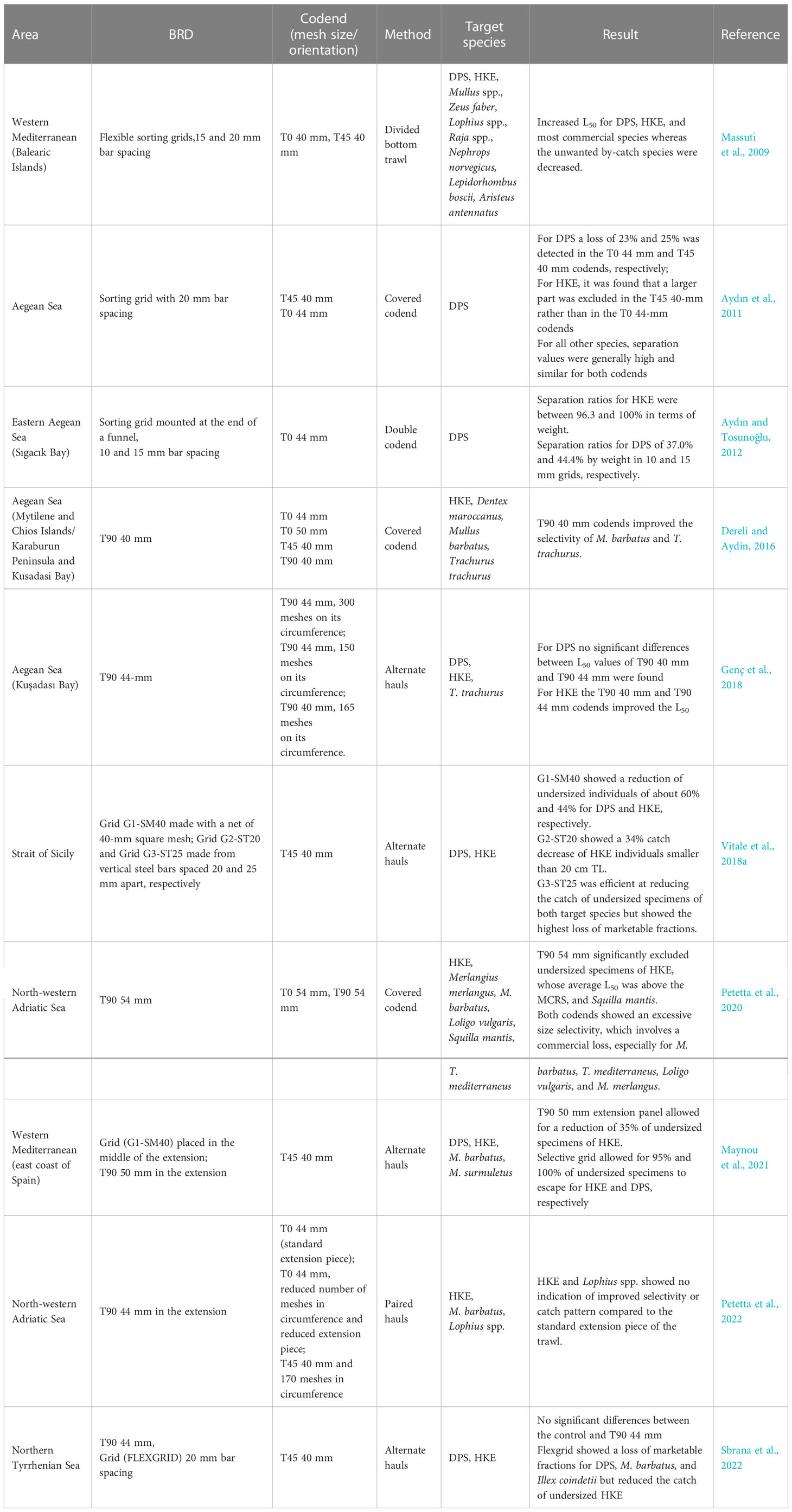
Table 5 Results of research in the Mediterranean Sea during which the sorting grid or T90 mesh was tested.
In other Mediterranean demersal trawl fisheries, according to the present study, a substantial improvement in DPS and HKE selectivity was found through the incorporation of a sorting grid in the trawl net (Massutí et al., 2009; Aydın et al., 2011; Aydın and Tosunoğlu, 2012). Recently, in the Adriatic Sea, an improvement in the catch pattern of HKE was found even if a loss of marketable DPS was at the same time detected (Table 5; Sbrana et al., 2022).
Similar to the present study, an improvement in the selectivity of HKE was found using a T90 50 mm codend in the Adriatic Sea, even if the nominal mesh size was inefficient at retaining specimens of commercial sizes of Mullus barbatus (Linnaeus, 1758), Trachurus mediterraneus (Steindachner, 1868), Loligo vulgaris (Lamarck, 1798), and Merlangius merlangus (Linnaeus, 1758; Petetta et al., 2020). Conversely, an increase in selectivity for mantis shrimp (Squilla mantis) (Linnaeus, 1758), allowing the escape of juvenile individuals often discarded by fishers, was reported. In the Aegean Sea, the T90 44 mm codend improved in the size of the first capture of HKE (Genç et al., 2018) whereas the T90 40 mm improved selectivity for M. barbatus and T. trachurus (Dereli and Aydin, 2016). Recently, on the eastern coast of Spain, modifying trawl extension with a T90 50 mm panel resulted in decreased fishing mortality for younger age classes of HKE and M. barbatus (Maynou et al., 2021), while in the Adriatic Sea (Petetta et al., 2022), and northern Tyrrhenian Sea (Sbrana et al., 2022) the application of a T90 40 mm panel in the extension piece did not significantly reduce the catch of juveniles of the target species (Table 5).
Given that demersal twin trawls are not present in the Strait of Sicily, the trawlers involved in this study were as similar as possible to those available to collaborate. Therefore, to verify whether the slight differences among vessels could introduce a potential bias in the sampling design, the swept areas were estimated and compared by haul. The results showed negligible differences between the swept areas amounting to no more than 5% (Table S1). The inevitable slight differences in the allocation of the hauls were implicitly accommodated considering the random effect (the hauls) within matrix D, which measures the variation in relative catch rate between paired hauls, which are assumed to occur at random and to average out over a series of paired hauls (Fryer et al., 2003; Holst and Revill, 2009). In addition, to corroborate the minimal effect of haul spatial allocation, the distance (at the beginning, intermediate, and final haul points) among vessels by haul was measured. Except for the fourth haul of the second day, during which distance reached a maximum of 2.3 nm during the intermediate and final haul points, the distances among vessels during the survey were negligible, ranging between 0.02 and 1.5 nm (Figure S4). Moreover, all fishing operations were conducted on the same biocenosis (Table 3) ensuring that the differences in catch rates were due to the different selectivity of the gear. The shorter haul duration in the present study (90 min) compared to the commercial hauls’ duration (120–150 min) might be considered a potential weakness. This shorter time was due to the trade-off between the logistics needed to carry out all of the hauls in 1 day and having a haul that was long enough to collect a sufficient number of specimens.
Overall, the findings of the present study are consistent with those of previous studies obtained in other areas of the Mediterranean Sea, emphasising DPS and HKE a selectivity improvement through the adoption of the Grid-T45 40 mm and T90 50 mm codend mounted on commercial trawl nets. These findings confirmed that in a multi-specific fishery, such as Mediterranean otter trawling, it is unrealistic to secure a gear configuration that is ideally suited for all species (Fiorentino and Vitale, 2021; Lucchetti et al., 2021). This is because to the different shapes, sizes, swimming abilities, and behaviours of the various species caught during trawling activities. Therefore, it is important to explore technological solutions that are selective for the main target species of trawl fishery, such as DPS in the Strait of Sicily, with acceptable levels of losses of valuable by-catch, such as HKE, and mitigation of the impact on benthic habitat and communities (Maynou et al., 2021), considering the different behaviour and vertical distribution from the seabed of the species.
In addition, given that the success of the adoption of gear is affected by the acceptance of fishers, their viewpoints are of paramount importance. During the campaign, no negative feedback toward the use of sorting grids from the involved fishers was detected, and no handling issues were raised from them. As for concerns relating to the T90 50 mm, even though it was a very simple modification without any possible handling issues, some concerns were raised by the fishers owing to the important loss of marketable DPS.
Therefore, in the future, it will be of vital importance to take into account the trade-off between the socio-economic and ecological points of view and to engage with as many fishers as possible in developing and optimising more selective gear (e.g., Geraci et al., 2019; Sardo et al., 2020b; Geraci et al., 2021b) to be translated into the decision-making process of the management regulations.
However, before transferring the tested BRDs to fishing enterprises and improving the selectivity of bottom trawling, is desirable to carry out generously planned surveys using commercial vessels fishing in different conditions (time, season, and grounds) with a shared protocol, and with fishing gear that is comparable as much as possible. Once more robust data on the effect of BRDs are obtained, mitigation of the current poor exploitation pattern of DPS and HKE could be achieved by adopting a set of management measures. In particular, the Fisheries Restricted Areas where bottom trawling is prohibited, implemented by the GFCM to protect juveniles of HKE and DPS in the Strait of Sicily (Russo et al., 2019; Di Maio et al., 2022), could be coupled with the adoption of a boundary zone in which trawling is allowed only for vessels that mount a BRD that minimises the capture of undersized individuals. Another measure could be the introduction of a total allowable catch for DPS and the application of the T90 50 mm codend when the quota is reached. All these potential management rules should be carefully monitored to determine their effective application. In addition, as already shown by Vitale et al. (2018b), in the near future, to simulate the effect of mounting the tested BRDs or the adoption of the above-mentioned management rules, it would be worthwhile to incorporate the selectivity results in an ecosystem model (e.g., Ecopath With Ecosim) to assess the effects not only on commercial target species but also on the other components of the trophic web in the area (Agnetta et al., 2022).
In conclusion, although further studies should be carried out in the future to test different fishing arrangements, the investigated gear appears to be promising tools to contribute to reducing the overexploitation of DPS and HKE at the same time to ensure long-term socio-economic sustainability of the fishing process in-line with the goals of the EU Common Fisheries Policy (reg. EC 1380/2013).
Data availability statement
The raw data supporting the conclusions of this article will be made available by the authors, without undue reservation.
Author contributions
SV and FFi: conceptualization. MG: formal analysis. MG, FFa, DS, VG, and GS: data curation. MG, FFa, FM, DS, VG, GS, PC, and DM: data collection and figures. SV and FFi: validation. MG: writing – original draft. MG, VG, FM, FFa, DS, FFi, GS, PC, DM, and SV: writing – review and editing. All authors contributed to the article and approved the submitted version.
Funding
This work was conducted under the consultancy service provided by the WWF Mediterranean (project number: 9E204550).
Acknowledgments
The research leading to these results has been conceived under the International PhD Program “Innovative Technologies and Sustainable Use of Mediterranean Sea Fishery and Biological Resources (www.FishMed-PhD.org).” This study represents partial fulfilment of the requirements for the Ph.D. thesis of MG. We would like to thank Dr Marco Costantini for his genuine collaboration, Dr Giandomenico Cassano and Editage (www.editage.com) for the English language editing. In addition, we would like to thank the reviewers who substantially improved the quality of the manuscript.
Conflict of interest
The authors declare that the research was conducted in the absence of any commercial or financial relationships that could be construed as a potential conflict of interest.
Publisher’s note
All claims expressed in this article are solely those of the authors and do not necessarily represent those of their affiliated organizations, or those of the publisher, the editors and the reviewers. Any product that may be evaluated in this article, or claim that may be made by its manufacturer, is not guaranteed or endorsed by the publisher.
Supplementary material
The Supplementary Material for this article can be found online at: https://www.frontiersin.org/articles/10.3389/fmars.2023.1011605/full#supplementary-material
SUPPLEMENTARY FIGURE 1 | Scheme of the control net used in the campaign, with details of the length and mesh number by net portion.
SUPPLEMENTARY FIGURE 2 | Scheme of the test net with sorting grid (T45 40 mm) used in the campaign, with details of its insertion, the length, and mesh number by net portion.
SUPPLEMENTARY FIGURE 3 | Scheme of the test net with T90 50 mm codend used in the campaign, with details of the length, and mesh number by net portion.
SUPPLEMENTARY FIGURE 4 | Distance of among vessels, in nautical miles, during the initial, intermediate, and final haul position over the days (columns), and hauls (rows).
References
Agnetta D., Badalamenti F., Colloca F., Cossarini G., Fiorentino F., Garofalo G., et al. (2022). Interactive effects of fishing effort reduction and climate change in a central Mediterranean fishing area: Insights from bio-economic indices derived from a dynamic food-web model. Front. Mar. Sci. 9. doi: 10.3389/fmars.2022.909164
Aydın C., Tokaç A., Aydın İ., Erdoğan U., Maktay B. (2011). Species selectivity in the Eastern Mediterranean demersal trawl fishery using grids to reduce non-target species. J. Appl. Ichthyol. 27 (1), 61–66. doi: 10.1111/j.1439-0426.2010.01605.x
Aydın C., Tosunoğlu Z.A.F.E.R. (2012). Evaluation of sorting grids for deepwater rose shrimp (Parapenaeus longirostris) in the Eastern Mediterranean demersal trawl fishery. J. Appl. Ichthyol. 28 (1), 102–106. doi: 10.1111/j.1439-0426.2011.01897.x
Bahamon N., Sardà F., Suuronen P. (2007). Selectivity of flexible size-sorting grid in Mediterranean multispecies trawl fishery. Fish. Sci. 73 (6), 1231–1240. doi: 10.1111/j.1444-2906.2007.01460.x
Bates D., Mächler M., Bolker B., Walker S. (2015). Fitting linear mixed-effects models using lme4. J. Stat. Software 67 (1), 1–48. doi: 10.18637/jss.v067.i01
Beverton R. J. H., Holt S. J. (1957). On the dynamics of exploited fish populations (London: Chapman and Hall), 39.
Brčić J., Herrmann B., De Carlo F., Sala A. (2015). Selective characteristics of a shark-excluding grid device in a Mediterranean trawl. Fish. Res. 172, 352–360. doi: 10.1016/j.fishres.2015.07.035
Brooks M. E., Kristensen K., Benthem K. J., Magnusson A., Berg C. W., Nielsen A., et al. (2017). glmmTMB balances speed and flexibility among packages for zero-inflated generalized linear mixed modeling. R J. 9, 378–400. doi: 10.32614/rj-2017-066
Caddy J. F. (1990). Options for the regulation of Mediterranean demersal fisheries. Nat. Resour. Model. 4 (4), 427–475. doi: 10.1111/j.1939-7445.1990.tb00219.x
Cárdenas E. D., Ávila de Melo A., Iglesias S., Saborido-Rey F. (1997). Selectivity of 130 mm mesh size in deep sea bottom trawl fishery in NAFO regulatory area. NAFO Sci. Coun. Stud. 30, 21–25.
Coll M., Libralato S. (2012). Contributions of food web modelling to the ecosystem approach to marine resource management in the Mediterranean Sea. Fish Fish (Oxf). 13 (1), 60–88. doi: 10.1111/j.1467-2979.2011.00420.x
Colloca F., Cardinale M., Maynou F., Giannoulaki M., Scarcella G., Jenko K., et al. (2013). Rebuilding Mediterranean fisheries: a new paradigm for ecological sustainability. Fish Fish. 14 (1), 89–109. doi: 10.1111/j.1467-2979.2011.00453.x
Colloca F., Scarcella G., Libralato S. (2017). Recent trends and impacts of fisheries exploitation on Mediterranean stocks and ecosystems. Front. Mar. Sci. 4. doi: 10.3389/fmars.2017.00244
Cosgrove R., Browne D., Minto C., Tyndall P., Oliver M., Montgomerie M., et al. (2019). A game of two halves: Bycatch reduction in Nephrops mixed fisheries. Fish. Res. 210, 31–40. doi: 10.1016/j.fishres.2018.09.019
Dereli H., Aydin C. (2016). Selectivity of commercial and alternative codends for four species in the Eastern Mediterranean demersal trawl fishery. Turk. J. Fish. Aquat. Sci. 16 (4), 477–493. doi: 10.4194/1303-2712-v16_4_25
Deval M. C., Özgen G., Özbilgin H. (2016). Selectivity of 50 mm T0 and T90 codends for commercial shrimp species in the Turkish deepwater trawl fishery, Eastern Mediterranean. J. Appl. Ichthyol. 32 (6), 1041–1057. doi: 10.1111/jai.13128
Di Lorenzo M., Sinerchia M., Colloca F. (2018). The north sector of the strait of Sicily: a priority area for conservation in the Mediterranean Sea. Hydrobiologia 821 (1), 235–253. doi: 10.1007/s10750-017-3389-7
Di Maio F., Geraci M. L., Scannella D., Russo T., Fiorentino F. (2022). Evaluation of the economic performance of coastal trawling off the southern coast of Sicily (Central Mediterranean Sea). Sustainability 2022 (14), 4743. doi: 10.3390/su14084743
Engås A., Jørgensen T., West C. W. (1998). A species-selective trawl for demersal gadoid fisheries. ICES J. Mar. Sci. 55 (5), 835–845. doi: 10.1006/jmsc.1998.0352
EU (2013) Regulation (EU) no 1380/2013 of the European parliament and of the council of 11 December 2013 on the common fisheries policy, amending council regulations (EC) no 1954/2003 and (EC) no 1224/2009 and repealing council regulations (EC) no 2371/2002 and (EC) no 639/2004 and council decision 2004/585/EC. 2013. Available at: http://data.europa.eu/eli/reg/2013/1380/oj.
EU (2019). “Regulation (EU) 2019/1241 of the European parliament and of the council of 20 June 2019 on the conservation of fisheries resources and the protection of marine ecosystems through technical measures,” in Official journal of the European union, vol. 198). , 97.
Falsone F., Gancitano V., Geraci M. L., Sardo G., Scannella D., Serena F., et al. (2022). Assessing the stock dynamics of elasmobranchii off the southern coast of Sicily by using trawl survey data. Fishes 7, 136. doi: 10.3390/fishes7030136
Ferro R. S. T., Jones E. G., Kynoch R. J., Fryer R. J., Buckett B. E. (2007). Separating species using a horizontal panel in the Scottish north Sea whitefish fishery. ICES J. Mar. Sci. 64 (8), 1543–1550. doi: 10.1093/icesjms/fsm099
Fiorentino F., Vitale S. (2021). How can we reduce the overexploitation of the Mediterranean resources? Front. Mar. Sci. 8. doi: 10.3389/fmars.2021.674633
Food and Agriculture Organization (FAO) (2020). The state of Mediterranean and black Sea fisheries 2020 (Rome: General Fisheries Commission for the Mediterranean). doi: 10.4060/cb2429en
Fryer R. J., Zuur A. F., Graham N. (2003). Using mixed models to combine smooth size-selection and catch-comparison curves over hauls. Can. J. Fish. Aquat. Sci. 60 (4), 448–459. doi: 10.1139/f03-029
Genç T.Ş., Atamanalp M., Aydın C. (2018). Selectivity of turned meshes codends for deepwater rose shrimp (Parapenaeus longirostris), horse mackerel, (Trachurus trachurus) and European hake (Merluccius merluccius) in the Aegean Sea. Ege J. Fisheries Aquat. Sci. 35 (2), 157–168. doi: 10.12714/egejfas.2018.35.2.08
Geraci M. L., Colloca F., Falsone F., Fiorentino F., Gancitano V., Sardo G., et al. (2021a). How is artificial lighting affecting the catches in deep water rose shrimp trawl fishery of the central Mediterranean Sea? Ocean Coast. Management. 215, 105970. doi: 10.1016/j.ocecoaman.2021.105970
Geraci M. L., Di Lorenzo M., Falsone F., Scannella D., Di Maio F., Colloca F., et al. (2019). The occurrence of Norwegian skate, Dipturus nidarosiensis (Elasmobranchii: Rajiformes: Rajidae), in the strait of Sicily, central Mediterranean. Acta Ichthyol. Piscat. 49, 203–208. doi: 10.3750/aiep/02566
Geraci M. L., Ragonese S., Scannella D., Falsone F., Gancitano V., Mifsud J., et al. (2021b). Batoid abundances, spatial distribution and life history traits in the strait of Sicily (Central Mediterranean sea): Bridging a knowledge gap through three decades of survey. Animals. 11, 2189. doi: 10.3390/ani11082189
GFCM (2007). Recommendations and resolutions on Mediterranean fisheries management - resolution GFCM/31/2007/3 40 mm square mesh size in codend of trawl nets exploiting demersal resources. Kayala, Greece: FAO-GFCM 39, GFCM.
GFCM (2018). Working group on stock assessment of demersal species (WGSAD) (FAO HQ, Rome, Italy: Scientific Advisory Committee on Fisheries (SAC), 79.
Gorelli G., Sardà F., Company J. B. (2016). Fishing effort increase and resource status of the deep-sea red shrimp Aristeus antennatus (Risso 1816) in the Northwest Mediterranean Sea since the 1950s. Rev. Fish. Sci. Aquac. 24 (2), 192–202. doi: 10.1080/23308249.2015.1119799
Graham N., Fryer R. J. (2006). Separation of fish from Nephrops norvegicus into a two-tier cod-end using a selection grid. Fish. Res. 82 (1–3), 111–118. doi: 10.1016/j.fishres.2006.08.011
Holst R., Revill A. (2009). A simple statistical method for catch comparison studies. Fish. Res. 95, 254–259. doi: 10.1016/j.fishres.2008.09.027
Hothorn T., Bretz F., Westfall P. (2008). Simultaneous inference in general parametric models. Biom. J. 50 (3), 346–363. doi: 10.1002/bimj.200810425
ICES. (2020). ICES workshop on innovative fishing gear (WKING). ICES Sci. Rep. 2, 96. doi: 10.17895/ices.pub.7528
Jarboui O., Ceriola L., Fiorentino F., Ünal V. (2022). “Current fisheries management in the strait of Sicily and progress towards an ecosystem approach,” in Transition towards an ecosystem approach to fisheries in the Mediterranean Sea – lessons learned through selected case studies. Ed. Vasconcellos M. (Rome: FAO), 147–162. FAO Fisheries and Aquaculture Technical Paper No. 681.
Karlsen J. D., Krag L. A., Herrmann B., Lund H. (2019). Using vertical distribution to separate fish from crustaceans in a mixed species trawl fishery. Can. J. Fish. Aquat. Sci. 76 (10), 1781–1794. doi: 10.1139/cjfas-2018-0313
Larsen R. B., Herrmann B., Brčić J., Sistiaga M., Cerbule K., Nielsen K. N., et al. (2021). Can vertical separation of species in trawls be utilized to reduce bycatch in shrimp fisheries? PLoS One 16 (3), e0249172. doi: 10.1371/journal.pone.0249172
Lomeli M. J., Wakefield W. W., Herrmann B., Dykstra C. L., Simeon A., Rudy D. M., et al. (2021). Use of artificial illumination to reduce pacific halibut bycatch in a US West coast groundfish bottom trawl. Fish. Res. 233, 105737. doi: 10.1016/j.fishres.2020.105737
Lucchetti A., Punzo E., Virgili M. (2016). Flexible turtle excluder device (TED): An effective tool for Mediterranean coastal multispecies bottom trawl fisheries. Aquat. Living Resour. 29 (2), 201. doi: 10.1051/alr/2016016
Lucchetti A., Virgili M., Vasapollo C., Petetta A., Bargione G., Li Veli D., et al. (2021). An overview of bottom trawl selectivity in the Mediterranean Sea. Mediterr. Mar. Sci. 22 (3), 566–585. doi: 10.12681/mms.26969
Lucchetti A., Bargione G., Petetta A., Vasapollo C., Virgili M. (2019). Reducing Sea Turtle Bycatch in the Mediterranean Mixed Demersal Fisheries. Front. Mar. Sci. 6, 387. doi: 10.3389/fmars.2019.00387
Massutí E., Ordines F., Guijarro B. (2009). Efficiency of flexible sorting grids to improve size selectivity of the bottom trawl in the Balearic islands (western Mediterranean), with comparison to a change in mesh codend geometry. J. Appl. Ichthyol. 25 (2), 153–161. doi: 10.1111/j.1439-0426.2009.01225.x
Maynou F., García-de-Vinuesa A. G., Martínez-Baños P., Sánchez P., Demestre M. (2021). Relative catch performance of two gear modifications used to reduce bycatch of undersized fish and shrimp in Mediterranean bottom trawl fisheries. Mar. Coast. Fish. 13 (5), 518–533. doi: 10.1002/mcf2.10178
Melli V., Herrmann B., Karlsen J. D., Feekings J. P., Krag L. A. (2020). Predicting optimal combinations of by-catch reduction devices in trawl gears: A meta-analytical approach. Fish Fish (Oxf). 21 (2), 252–268. doi: 10.1111/faf.12428
Micheli F., Halpern B. S., Walbridge S., Ciriaco S., Ferretti F., Fraschetti S., et al. (2013). Cumulative human impacts on Mediterranean and black Sea marine ecosystems: assessing current pressures and opportunities. PLoS One 8 (12), e79889. doi: 10.1371/journal.pone.0079889
Milisenda G., Vitale S., Massi D., Enea M., Gancitano V., Giusto G. B., et al. (2017). Spatio-temporal composition of discard associated with the deep water rose shrimp fisheries (Parapenaeus longirostris, Lucas 1846) in the south-central Mediterranean Sea. Mediterr. Mar. Sci. 18 (1), 53–63. doi: 10.12681/mms.1787
Morrissey M. T., Almonacid S. (2005). Rethinking technology transfer. J. Food Eng. 67, 135–145. doi: 10.1016/j.jfoodeng.2004.05.05
Pauly D. (1980). “A new methodology for rapidly acquiring basic information on tropical fish stocks: growth, mortality and stock-recruitment relationships,” in Stock assessment for tropical small-scale fisheries (Rhode Island, Narragansett: Proc. Int. Workshop Univ), 154–172.
Petetta A., Herrmann B., Virgili M., De Marco R., Canduci G., Li Veli D., et al. (2020). Estimating selectivity of experimental diamond (T0) and turned mesh (T90) codends in multi-species Mediterranean bottom trawl. Mediterr. Mar. Sci. 21 (3), 545–557. doi: 10.12681/mms.22789
Petetta A., Herrmann B., Virgili M., Li Veli D., Brinkhof J., Lucchetti A. (2022). Effect of extension piece design on catch patterns in a Mediterranean bottom trawl fishery. Front. Mar. Sci. 9. doi: 10.3389/fmars.2022.876569
Piroddi C., Coll M., Liquete C., Macias D., Greer K., Buszowski J., et al. (2017). Historical changes of the Mediterranean Sea ecosystem: modelling the role and impact of primary productivity and fisheries changes over time. Sci. Rep. 7 (1), 1–18. doi: 10.1038/srep44491
Pravin P., Gibinkumar T. R., Sabu S., Boopendranath M. (2011). Hard bycatch reduction devices for bottom trawls: a review. Fishery Technology. 48 (2), 107–118.
R Core Team (2020). R: A language and environment for statistical computing (Vienna, Austria: R Foundation for Statistical Computing). Available at: https://www.R-project.org/.
Russo T., D'Andrea L., Franceschini S., Accadia P., Cucco A., Garofalo G., et al. (2019). Simulating the effects of alternative management measures of trawl fisheries in the central Mediterranean Sea: application of a multi-species bio-economic modelling approach. Front. Mar. Sci. 6. doi: 10.3389/fmars.2019.00542
Sardà F., Bahamón N., Sardà-Palomera F., Molí B. (2005). Commercial testing of a sorting grid to reduce catches of juvenile hake (Merluccius merluccius) in the western Mediterranean demersal trawl fishery. Aquat. Living Resour. 18 (1), 87–91. doi: 10.1051/alr:2005010
Sardà F., Molí B., Palomera I. (2004). Preservation of juvenile hake (Merluccius merluccius l) in the western Mediterranean demersal trawl fishery by using sorting grids. Sci. Mar. 68 (3), 435–444. doi: 10.3989/scimar
Sardo G., Geraci M. L., Scannella D., Falsone F., Vitale S. (2020b). New records of two uncommon species, Calappa tuerkayana pastore 1995 (Decapoda, calappidae) and Parasquilla ferrussaci (Roux 1828) (Stomatopoda, parasquillidae), from the strait of Sicily (central Mediterranean Sea). Arxius Miscellània Zoològica 18, 113–121. doi: 10.32800/amz.2020.18.0113
Sardo G., Okpala C. O. R., Geraci M. L., Fiorentino F., Vitale S. (2020a). The effects of different artificial light wavelengths on some behavioural features of juvenile pelagic Atlantic horse mackerel, Trachurus trachurus (Actinopterygii: Perciformes: Carangidae). Acta Ichthyol. Piscat 50 (1), 85–92. doi: 10.3750/AIEP/02709
Sbrana M., De Carlo F., Ligas A., Massaro A., Musumeci C., Rossetti I., et al. (2022). Testing experimental devices in the extension piece to increase the selectivity of bottom trawl in the nw Mediterranean. Front. Mar. Sci. 9. doi: 10.3389/fmars.2022.1017766
Sparre P., Venema S. C. (1998). Introduction to tropical fish stock assesment (Part 1 manual) Vol. 306 (Rome: FAO Fish. Tech. Pap.), 407.
Tsagarakis K., Carbonell A., Brčić J., Bellido J. M., Carbonara P., Casciaro L., et al. (2017). Old info for a new fisheries policy: Discard ratios and lengths at discarding in EU Mediterranean bottom trawl fisheries. Front. Mar. Sci. 4 (99). doi: 10.3389/fmars.2017.00099
Vasilakopoulos P., Maravelias C. D., Tserpes G. (2014). The alarming decline of Mediterranean fish stocks. Curr. Biol. 24 (14), 1643–1648. doi: 10.1016/j.cub.2014.05.070
Vitale S., Enea M., Milisenda G., Gancitano V., Geraci M. L., Falsone F., et al. (2018b). Modelling the effects of more selective trawl nets on the productivity of European hake (Merluccius merluccius) and deep-water rose shrimp (Parapenaeus longirostris) stocks in the strait of Sicily. Sci. Mar. 82 (S1), 199–208. doi: 10.3989/scimar.04752.03a
Vitale S., Milisenda G., Gristina M., Baiata P., Bonanomi S., Colloca F., et al. (2018a). Toward more selective Mediterranean trawl fisheries: are the juveniles trash excluder devices effective tools to reduce the by-catch of juveniles? Sci. Mar. 82 (S1), 215–223. doi: 10.3989/scimar.04751.28A
Keywords: selectivity, discard, Parapenaeus longirostris, Merluccius merluccius, T90 codend, sorting grid
Citation: Geraci ML, Sardo G, Scannella D, Falsone F, Di Maio F, Gancitano V, Fiorentino F, Chirco P, Massi D and Vitale S (2023) Exploring the feasibility of technological transfers of two by-catch reduction devices in the crustacean bottom trawling of the central Mediterranean. Front. Mar. Sci. 10:1011605. doi: 10.3389/fmars.2023.1011605
Received: 04 August 2022; Accepted: 06 March 2023;
Published: 26 April 2023.
Edited by:
Valentina Melli, Technical University of Denmark, DenmarkReviewed by:
Alex Souza Lira, Federal University of Sergipe, BrazilAmanda Williard, University of North Carolina Wilmington, United States
Copyright © 2023 Geraci, Sardo, Scannella, Falsone, Di Maio, Gancitano, Fiorentino, Chirco, Massi and Vitale. This is an open-access article distributed under the terms of the Creative Commons Attribution License (CC BY). The use, distribution or reproduction in other forums is permitted, provided the original author(s) and the copyright owner(s) are credited and that the original publication in this journal is cited, in accordance with accepted academic practice. No use, distribution or reproduction is permitted which does not comply with these terms.
*Correspondence: Giacomo Sardo, Z2lhY29tby5zYXJkb0BpcmJpbS5jbnIuaXQ=
 Michele Luca Geraci
Michele Luca Geraci Giacomo Sardo
Giacomo Sardo Danilo Scannella
Danilo Scannella Fabio Falsone
Fabio Falsone Federico Di Maio1,2
Federico Di Maio1,2 Fabio Fiorentino
Fabio Fiorentino Sergio Vitale
Sergio Vitale